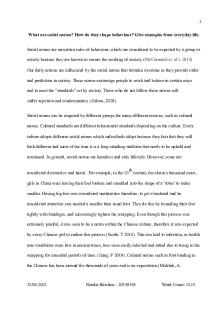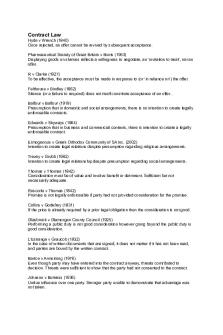CH3-4 Ethics and Norms PDF

Summary
Chapter 3 Emphasizing Cultures, Ethics and Norms
Those within a society tend to perceive their own cultures, ethics and norms as morally right this is called ethnocentrism.
...
Description
Chapter 3 Emphasizing Cultures, Ethics and Norms Those within a society tend to perceive their own cultures, ethics and norms as morally right this is called ethnocentrism.
1. Culture Geert Hofstede defines culture as the collective programming of the mind which distinguishes the members of one group or category of people from another. | There are two factors why English is the global business language. 1. English speaking countries contribute the largest share (40%) of global output 2. Recent globalization has called for the use of one common language. Countries who share the language tend to trade more with each other. Social structure refers to how a society broadly organizes its members. Social stratification is a hierarchical arrangement of individuals into social categories. Social mobility refers to the degree to which members from a lower social category can rise to a higher status. MNE has to be sensitive to these topics when hiring local people. Education is one of the factors holding back social mobility and stratification.
2. Cultural Differences There are three main approaches into cultural differences: 1. The context approach. Context is the underlying background upon which social interaction takes place. In low context cultures (North America & Western Europe) communication is taken at face value without much unspoken context. In high context cultures (Arab & Asian countries) there is a lot of unspoken context. 2. The Cluster Approach. Is about groups of countries which share similar cultures in one cluster. People and firms are more comfortable doing business with people from the same Cluster. 3. The Dimension Approach. This is the more influential dimension, because (1) context approach only has one dimension (2) the cluster approach doesn’t offer much when trading in the same cluster. Hofstede proposed five dimensions: ● a. Power distance. Is the extent to which less powerful members within a country expect and accept that power is distributed unequally. ● b. Individualism. The idea that an identity is fundamentally from an individual ● c. Masculinity. Traditional role model on occupation ● d. Uncertainty avoidance. Accept or avoid ambiguous situations and uncertainty ● e. Long term orientation
3. Ethics Ethics refers to the principles, standards and norms of conduct that govern individual and firm behavior. Three views: (1) negative: firms will do ethics when under social pressure to appear more legitimate (2) positive; some firms may be motivated to do things right regardless of social pressure (3) instrumental; good ethics is a useful instrument to help make money. Ethical relativism is when in Rome, do as the Romans do. Ethical imperialism is the belief that there’s only one set of Ethics and we have it. Thomas Donaldson proposed a middle way: ● (1) Respect human dignity and basic rights ● (2) Respect local traditions ● (3) Respect for institutional context.
4 Norms and Ethical Challenges There are four broad strategies: 1. Reactive strategy is passive. Firms don’t feel compelled to act when problems arise, and denial is usually the first line of defense. 2. Defensive strategy focuses on regulatory compliance 3. Accommodative strategy is accepting responsibility becomes an organizational norm, and cognitive beliefs and values are increasingly internalized 4. Proactive strategy is to anticipate institutional changes and do more than required.
5. Debates and Extensions 1. Economic development: Western values versus Eastern values. The superiority of the Western values has recently been challenged by the Islam and the Asian tradition. 2. Cultural Change: Convergence versus divergence. One side says that there is a great deal of convergence, especially toward individualism and consumerism. The other says that consumption doesn’t mean Westernization in values. 3. Opportunism versus individualism/collectivism. Transaction cost theorists say that opportunists are a minority in any population. Note that more collectivists are more collaborative when dealing with the in group, they see the out group as not part of us. Acquisition of cultural intelligence passes through three phases: (1) awareness (2) knowledge and (3) skills. Skills are the hardest to learn.
Chapter 4 Leveraging Capabilities Globally A leading tool in global business is a SWOT analysis.
1. Understanding Resources and Capabilities Resources are defined as the tangible and intangible assets a firm uses to choose and implement its strategies. Tangible resources and capabilities are assets that are observable and easily quantified, but intangible resources are harder to observe and more difficult to quantify.
2. Resources, capabilities and the value chain: in house versus outsourcing The value chain consists of two areas; primary and support activities. The key is to see if the firm has resources to perform a particular activity in a manner superior to competitors is called benchmarking. As a product loses its ability to command high prices and high margins through competition, it undergoes commoditization. Outsourcing is defined as turning over an organizational activity to an outside supplier that will perform the activity on behalf of the local firm. We define four terms based on locations and modes:
3. Analyzing resources capabilities VRIO Framework
and with a
Value, rarity, imitability and organizational aspects of a firm lead to a VRIO framework 1. Value. Only value adding resources can lead to competitive advantage 2. Rarity; How rare are the valuable resources and capabilities? 3. Imitability. It’s more difficult to copy the intangible resources of a firm. Imitation is difficult,
because of causal ambiguity. This means the difficulty of identifying the actual cause of a firm’s successful performance. 4. Organization. Organizations are socially complex and hard to copy.
4. Debates and Extensions 1. Domestic resources versus international capabilities. When a firm is domestically successful can it also win internationally? The answer to Are domestic resources and crossborder capabilities essentially the same can be Yes or No depending on your argument. 2. Offshoring versus not Offshoring Because of digitization and commoditization a lot of work is offshored. Recent debate: is this good for the long-term West? Proponents argue that by offshoring firms can focus on their core capabilities. Critics make three points: ● 1. Strategic: If even core functions are offshored what’s left of the company. And offshoring would help rivals ● 2. Economically. It’s not sure whether developed economies gain more ● 3. Politically: that many large US countries which claim to be global, shouldn’t represent or be bound to American values....
Similar Free PDFs

CH3-4 Ethics and Norms
- 4 Pages

Ch34 copy - Numnjk
- 21 Pages

Norms and the Meaning Test Score
- 6 Pages

SOC241 Social Norms Assignment
- 1 Pages

Social Norms Essay
- 8 Pages

Classroom Norms activity
- 2 Pages

2017 ORF Norms
- 1 Pages

S4 Asceticism and ethics
- 4 Pages

Management and Ethics Simulation
- 5 Pages

Law and ethics cases
- 4 Pages
Popular Institutions
- Tinajero National High School - Annex
- Politeknik Caltex Riau
- Yokohama City University
- SGT University
- University of Al-Qadisiyah
- Divine Word College of Vigan
- Techniek College Rotterdam
- Universidade de Santiago
- Universiti Teknologi MARA Cawangan Johor Kampus Pasir Gudang
- Poltekkes Kemenkes Yogyakarta
- Baguio City National High School
- Colegio san marcos
- preparatoria uno
- Centro de Bachillerato Tecnológico Industrial y de Servicios No. 107
- Dalian Maritime University
- Quang Trung Secondary School
- Colegio Tecnológico en Informática
- Corporación Regional de Educación Superior
- Grupo CEDVA
- Dar Al Uloom University
- Centro de Estudios Preuniversitarios de la Universidad Nacional de Ingeniería
- 上智大学
- Aakash International School, Nuna Majara
- San Felipe Neri Catholic School
- Kang Chiao International School - New Taipei City
- Misamis Occidental National High School
- Institución Educativa Escuela Normal Juan Ladrilleros
- Kolehiyo ng Pantukan
- Batanes State College
- Instituto Continental
- Sekolah Menengah Kejuruan Kesehatan Kaltara (Tarakan)
- Colegio de La Inmaculada Concepcion - Cebu





